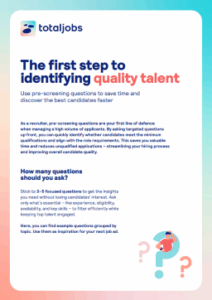
7 strategies for hiring seasonal workers
Table of Contents
- 1. Determine seasonal requirements
- 2. Start hiring early
- 3. Write optimised job descriptions
- 4. Advertise seasonal jobs
- 5. Leverage networks
- 6. Streamline the hiring process
- 7. Implement effective onboarding
- Setting yourself up for success
- FAQs

Recruiter Templates
Many industries face seasonal surges in demand. Retail, for instance, saw 3.2% growth last year in the run-up to Christmas, while events like Black Friday and Cyber Monday drive spikes in customer service and parcel deliveries. Similarly, hospitality businesses face peak demand during the summer months.
To stay agile and capitalise on these peaks, an effective seasonal hiring strategy is essential. In this article, we’ll explore how to attract and hire the right temporary staff when demand rises.
1. Determine your seasonal hiring requirements
Getting a potentially large number of temporary workers onboard at the right time can make or break your peak season. If you don’t hire enough part-time or full-time employees, competitors that do might be better placed to meet the changing demands of consumers.
An established organisation should have access to data from previous years that can provide a steer regarding future requirements for hiring seasonal workers. New organisations, on the other hand, may need to take more of a trial-and-error approach.
The main thing for these organisations is to understand what is affordable. This will require exploring:
- What is available in terms of budget
- Determining the resources they can use to onboard temporary employees

Tip: Organisations that over-hire seasonal staff might find that their profits don’t cover their additional staffing costs. As a result, it’s vital to understand exactly what your requirements are before hiring.
2. Start hiring early for the busy season
Once you know the requirements, it’s vital to start hiring as early as possible.

If you leave it until the last minute, there’s no guarantee the workers you need won’t already be snapped up by the competition. Our research shows that, as of September 2025, 21% of large businesses are already planning to hire more temporary staff in the next six months.
Remember, hiring workers takes time, whether they are permanent, full-time staff or seasonal employees on a more flexible contract.
For example, retailers such as John Lewis and Waitrose have previously revealed plans to hire additional staff for the Christmas period months in advance, highlighting their understanding of how crucial this is to meeting their long-term goals and objectives.

Pre-Screening Questions Template
3. Write optimised job descriptions
As with permanent staff, an efficient and transparent hiring process is central to finding seasonal workers to meet short-term increases in demand. For example, we found that 28% of candidates drop out of hiring processes, with 39% saying they want more transparency when it comes to role requirements.
So, to attract and appeal to top-tier candidates who are a good fit for the role, job descriptions targeted at seasonal workers should:
- Make it clear exactly what the role being advertised entails.
- Use relevant keywords, highlighting words like ‘seasonal’ and ‘temporary’.
- Detail the job title and clearly outline the responsibilities and experience requirements.
- Highlight the benefits, such as loyalty bonuses or rewards, as these can not only attract applications but also encourage workers to return the following year.
- Outline the company culture, so you target the seasonal workers who will be a good fit.
4. Advertise seasonal jobs
Knowing where to advertise seasonal positions to ensure they reach jobseekers looking for temporary work is crucial to building the workforce required to handle increased demand during a specific period.
To increase the chances of their job postings reaching suitable candidates, employers can:
- Appeal to students: Students are often open to finding work during seasonal peaks due to their term dates, so publishing job ads targeting colleges and universities is a good place to start.
- Leverage recruitment platforms:Totaljobs is a great option for advertising seasonal jobs, with many organisations using our platform to fill temporary roles.
- Use job fairs: Many workers use job fairs to find their next temporary gig, so you can sign up for a stand to spread the word about your seasonal opportunities.
5. Leverage networks
Using your existing network is an invaluable way to source seasonal workers for your organisation.
This can include asking for support from current employees, as existing members of staff may know people who are looking for seasonal work and are therefore well placed to recommend them for a role.
Implementing an employee recruitment referral scheme is one way to encourage this, offering monetary incentives for staff to refer workers.

Employee Referral Kit
Another great way to source seasonal employees is reaching out to previous workers.
If you’ve hired temporary seasonal workers before, they may be open to returning. These workers come with the added benefit of having some familiarity with the role and organisation and therefore should require less training.
You can also determine which seasonal workers may be open to returning by conducting exit interviews at the end of their period of employment.

Exit Interview Toolkit
6. Streamline the hiring process
Streamlining the hiring process for seasonal workers helps to ensure that these employees can be onboarded quickly and are ready to help meet the increased demand of consumers.
The simplest way to do this is during the interview process, namely knowing how to conduct an interview effectively. While asking competency-based interview questions is vital to ensuring a candidate has the competencies required for success, putting together a more concise list of questions than you would use when hiring permanent employees can make the process more efficient.
For example, when interviewing a candidate for a temporary role, interviewers could ask:
- Have you ever worked in a position with a seasonal rush?
- Do you understand this is not a permanent role?
- Why are you looking for seasonal work?
- Do you have a flexible schedule?
7. Ensure effective onboarding for seasonal employment
Whether they are full-time or seasonal, workers are entitled to thorough onboarding, and implementing a smooth process is crucial to ensuring they can hit the ground running.
While it can take weeks to get a new full-time hire up to speed, seasonal workers need to be ready to do their part much faster. Fortunately, there are steps employers can take to expedite this process. This includes:
- Making sure all necessary paperwork is signed and filed swiftly.
- Setting up a quick and efficient seasonal worker training scheme, making clear their tasks and responsibilities, and providing practical examples if necessary.
- Providing space for questions and answers about their roles. Assigning mentors or managers to oversee seasonal workers to make sure they get the hang of things in the first few days.
- Conducting an evaluation after a few days to ensure there are no major gaps in knowledge.
Set yourself up for long-term seasonal success
In industries with fluctuating demand, timely hiring of seasonal workers is crucial as recruitment becomes increasingly challenging. Employers should prioritise workforce planning by identifying staffing needs early and streamlining the hiring process to ensure readiness for peak seasons.
A strong seasonal hiring strategy builds an agile workforce, helping businesses seize growth opportunities. Moreover, creating a positive and rewarding work environment can encourage seasonal employees to return, strengthening future recruitment efforts.
Frequently asked questions (FAQs)
When is the ideal time to start hiring seasonal workers?
It’s best to begin the process several weeks, or even months, in advance of your peak period. Early recruitment ensures you find suitable candidates before the demand rises.
How can employers attract qualified seasonal workers?
Create clear job adverts, emphasise flexible hours and short-term benefits, advertise on job boards and social media, and consider referrals from past seasonal staff or current employees.
What’s the best way to onboard seasonal staff quickly?
Use concise rolling onboarding sessions, assign mentors or buddies, provide brief role-specific training, and ensure clear instructions so seasonal workers can become productive fast.
What are common challenges when hiring seasonal staff?
Challenges include short training windows, variable availability, managing high turnover rates, and ensuring seasonal workers quickly align with company standards.
Explore articles
Receive the latest recruitment resources and
advice to boost your hiring
By providing us with your details you agree to our privacy policy and for us to keep you updated with the latest news, events,
and special offers from Totaljobs.











